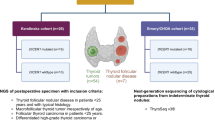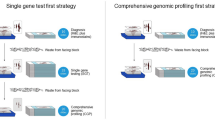ABSTRACT
Background
Activating somatic mutation of the BRAF V600E has been identified as the most common genetic event in papillary thyroid carcinoma (PTC) with a variable frequency (32–87 %) in different series by different methods. The BRAF V600E mutation is associated with various clinicopathological parameters. The mutation is an important factor for the management of the PTC patients. The objective of this study was to detect the BRAF V600E mutation in PTCs by peptide nucleic acid (PNA) clamp real-time PCR and to analyze the results with clinicopathological parameters.
Methods
We performed genetic analysis of BRAF V600E by PNA clamp real-time PCR in 211 PTCs in Korea, stratified by clinicopathological parameters.
Results
The BRAF V600E mutation was detected in 90 % of PTC cases, and it occurred significantly more often in female patients than in male patients (p = 0.001). The clinicopathological parameters of age, tumor size, and disease stage were not associated with the BRAF V600E mutation, while extrathyroid invasion (p = 0.031), lymph nodal metastasis (p = 0.002), and tumor multiplicity (p = 0.020) were.
Conclusions
The prevalence (90 %) of the BRAF V600E mutation in this study is the highest ever reported, confirming the key role of this mutation in PTC tumorigenesis. The BRAF V600E mutation was associated with aggressive clinical behaviors including extrathyroid invasion, lymph nodal metastasis and tumor multifocality. The PNA clamp real-time PCR method for the BRAF V600E mutation detection is sensitive and is applicable in a clinical setting.

Similar content being viewed by others
REFERENCES
Paterson IC, Greenlee R, Adams Jones D. Thyroid cancer in Wales, 1985–1996: a cancer registry–based study. Clin Oncol (R Coll Radiol). 1999;11:245–51.
Hay ID, Bergstralh EJ, Goellner JR, Ebersold JR, Grant CS. Predicting outcome in papillary thyroid carcinoma: development of a reliable prognostic scoring system in a cohort of 1779 patients surgically treated at one institution during 1940 through 1989. Surgery. 1993;114:1050–7.
Cohen Y, Xing M, Mambo E, et al. BRAF mutation in papillary thyroid carcinoma. J Natl Cancer Inst. 2003;95:625–7.
Xu X, Quiros RM, Gattuso P, Ain KB, Prinz RA. High prevalence of BRAF gene mutation in papillary thyroid carcinomas and thyroid tumor cell lines. Cancer Res. 2003;63:4561–7.
Fukushima T, Suzuki S, Mashiko M, et al. BRAF mutations in papillary carcinomas of the thyroid. Oncogene. 2003;22:6455–7.
Xing M, Westra WH, Tufano RP, et al. BRAF mutation predicts a poorer clinical prognosis for papillary thyroid cancer. J Clin Endocrinol Metab. 2005;90:6373–9.
Fugazzola L, Mannavola D, Cirello V, et al. BRAF mutations in an Italian cohort of thyroid cancers. Clin Endocrinol (Oxf). 2004;61:239–43.
Kim KH, Kang DW, Kim SH, Seong IO, Kang DY. Mutations of the BRAF gene in papillary thyroid carcinoma in a Korean population. Yonsei Med J. 2004;45:818–21.
Nakamura N, Carney JA, Jin L, et al. RASSF1A and NORE1A methylation and BRAF V600E mutations in thyroid tumors. Lab Invest. 2005;85:1065–75.
Kebebew E, Weng J, Bauer J, et al. The prevalence of prognostic value of BRAF mutation in thyroid cancer. Ann Surg. 2007;246:466–71.
Vasil’ev EV, Roumiantsev PO, Saenko VA, et al. Molecular analysis of structural abnormalities in papillary thyroid carcinoma genome. Mol Biol. 2004;38:538–48.
Gu LQ, Li FY, Zhao L, et al. BRAF V600E mutation and X-linked inhibitor of apoptosis expression in papillary thyroid carcinoma. Thyroid. 2009;19:347–54.
Nam JK, Jung CK, Song BJ, et al. Is the BRAF V600E mutation useful as a predictor of preoperative risk in papillary thyroid cancer? Am J Surg. 2012;203:436–41.
Kimura ET, Nikiforova MN, Zhu Z, Knauf JA, Nikiforov YE, Fagin JA. High prevalence of BRAF mutations in thyroid cancer: genetic evidence for constitutive activation of the RET/PTC-RAS-BRAF signaling pathway in papillary thyroid carcinoma. Cancer Res. 2003;63:1454–7.
Puxeddu E, Moretti S, Elisei R, et al. BRAF V599E mutation is the leading genetic event in adult sporadic papillary thyroid carcinomas. J Clin Endocrinol Metab. 2004;89:2414–20.
Perren A, Schmid S, Locher T, et al. BRAF and endocrine tumors: mutations are frequent in papillary thyroid carcinomas, rare in endocrine tumors of the gastrointestinal tract and not detected in other endocrine tumors. Endocr Relat Cancer. 2004;11:855–60.
Trovisco V, Vieira de Castro I, Soares P, et al. BRAF mutations are associated with some histological types of thyroid papillary carcinoma. J Pathol. 2004;202:247–51.
Soares P, Trovisco V, Rocha AS, et al. BRAF mutations and RET/PTC rearrangements are alternative events in the etiopathogenesis of PTC. Oncogene. 2003;22:4578–80.
Sykorova V, Dvorakova S, Ryska A, et al. BRAF V600E mutation in the pathogenesis of the large series of papillary thyroid carcinoma in Czech Republic. J Endocrinol Invest. 2010;33:318–24.
Nikiforova MN, Kimura ET, Gandhi M, et al. BRAF mutations in thyroid tumors are restricted to papillary carcinomas and anaplastic or poorly differentiated carcinomas arising from papillary carcinomas. J Clin Endocrinol Metab. 2003;88:5399–404.
Rowe LR, Bentz BG, Bentz JS. Detection of BRAF V600E activating mutation in papillary thyroid carcinoma using PCR with allele-specific fluorescent probe melting curve analysis. J Clinl Pathol. 2007;60:1211–5.
Kim J, Giuliano AE, Turner RR, et al. Lymphatic mapping establishes the role of BRAF gene mutation in papillary thyroid carcinoma. Ann Surg. 2006;244:799–804.
Sapio MR, Posca D, Troncone G, et al. Detection of BRAF mutation in thyroid papillary carcinomas by mutant allele-specific PCR amplification (MASA). Eur J Endocrinol. 2006;154:341–8.
Hayashida N, Namba H, Kumagai A, et al. A rapid and simple detection method for the BRAF T1796A mutation in fine-needle aspirated thyroid carcinoma cells. Thyroid. 2004;14:910–5.
Kim SK, Song KH, Lim SD, et al. Clinical and pathological features and the BRAF V600E mutation in patients with papillary thyroid carcinoma with and without concurrent Hashimoto thyroiditis. Thyroid. 2009;19:137–41.
Lyon E, Wittwer CT. LightCycler technology in molecular diagnostics. J Mol Diagn. 2009;11:93–101.
Demers DB, Curry ET, Egholm M, Sozer AC. Enhanced PCR amplification of VNTR locus D1S80 using peptide nucleic acid (PNA). Nucleic Acids Res. 1995;23:3050–5.
Jeong D, Jeong Y, Lee J, et al. Rapid and sensitive detection of KRAS mutation by peptide nucleic acid–based real-time PCR clamping: a comparison with direct sequencing between fresh tissue and formalin-fixed and paraffin embedded tissue of colorectal cancer. Korean J Pathol. 2011;45:151–9.
Kyger EM, Krevolin MD, Powell MJ. Detection of the hereditary hemochromatosis gene mutation by real-time fluorescence polymerase chain reaction and peptide nucleic acid clamping. Anal Biochem. 1998;260:142–8.
Taback B, Bilchik AJ, Saha S, et al. Peptide nucleic acid clamp PCR: a novel K-ras mutation detection assay for colorectal cancer micrometastases in lymph nodes. Int J Cancer. 2004;111:409–14.
Thiede C, Bayerdörffer E, Blasczyk R, Wittig B, Neubauer A. Simple and sensitive detection of mutations in the ras proto-oncogenes using PNA-mediated PCR clamping. Nucleic Acids Res. 1996;24:983–4.
Guan H, Ji M, Bao R, et al. Association of high iodine intake with the T1799A BRAF mutation in papillary thyroid cancer. J Clin Endocrinol Metab. 2009;94:1612–7.
Kim JY, Moon SJ, Kim KR, et al. Dietary iodine intake and urinary iodine excretion in normal Korean adults. Yonsei Med J. 2000;39:355–62.
Kim JY, Kim KR. Dietary iodine intake and urinary iodine excretion in patients with thyroid diseases. Yonsei Med J. 2000;41:22–8.
Ferlay J, Shin HR, Bray F, Forman D, Mathers C, Parkin DM. Globocan 2008 v1.2, Cancer incidence and mortality worldwide. IARC CancerBase 10 [Internet]. Lyon, France: International Agency for Research on Cancer; 2010. Available from: http://globocan.iarc.fr.
Ahmad T, Eisen T. Kinase inhibition with BAY 43-9006 in renal cell carcinoma. Clin Cancer Res. 2004;10(18 Pt 2):6388S–92S.
Sala E, Mologni L, Truffa S, Gactano C, Bollag GE, Gambacorti-Passerini C. BRAF silencing by short hairpin RNA or chemical blockade by PLX4032 leads to different responses in melanoma and thyroid carcinoma cells. Mol Cancer Res. 2008;6:751–9.
ACKNOWLEDGMENT
We thank the Gene Bank of Soonchunhyang University for providing materials for this research.
Author information
Authors and Affiliations
Corresponding author
Additional information
Dongjun Jeong and Yujun Jeong have contributed equally to this article.
Rights and permissions
About this article
Cite this article
Jeong, D., Jeong, Y., Park, J.H. et al. BRAF V600E Mutation Analysis in Papillary Thyroid Carcinomas by Peptide Nucleic Acid Clamp Real-time PCR. Ann Surg Oncol 20, 759–766 (2013). https://doi.org/10.1245/s10434-012-2494-0
Received:
Published:
Issue Date:
DOI: https://doi.org/10.1245/s10434-012-2494-0




